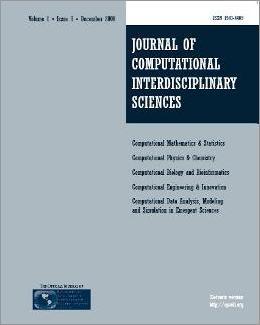
Editorial Office:
Management:
R. S. Oyarzabal
Technical Support:
D. H. Diaz
M. A. Gomez
W. Abrahão
G. Oliveira
Publisher by Knobook Pub


Editorial Office:
Management:
R. S. Oyarzabal
Technical Support:
D. H. Diaz
M. A. Gomez
W. Abrahão
G. Oliveira
Publisher by Knobook Pub
doi: 10.6062/jcis.2011.02.03.0045(Free PDF)
Rajnish Kumar, Anju Sharma, Pritish Varadwaj, Ausaf Ahmad and Ghulan Md Ashraf
Oral Bioavailability is the rate and extent to which an active drug substance is absorbed and becomes available to the general circulation. A computational model for the prediction of oral bioavailability is a vital initial step in the drug discovery. It is decisive for selecting the promising compounds for the next level optimizations and recognition for the clinical trials. In the present investigation we aimed to perform the oral bioavailability prediction by comparing three machine learning methods i.e. Support Vector Machine (SVM) based kernel learning, Artificial Neural Network (ANN) and Bayesian classification approach. The overall prediction efficiency of SVM based model for the test set was 96.85%, whereas according to the Bayesian classifier and ANN methods prediction efficiency was found to be 92.19% and 94.53% respectively. Thus the present results clearly suggested that the SVM based prediction of oral bioavailability of drugs is more efficient binary classification approach for the data under consideration.
Artificial Neural Network, Bayesian classification, oral bioavailability, prediction, Support Vector Machine.
[1] CANTU-PAZ E, NEWSAM S & KAMATH C. 2004. Feature selection in scientific applications. International Conference on Knowledge Discovery and data Mining, US.
[2] CHANG CC & LIN CJ. 2001. LIBSVM, version 2.81, http://www.csie.ntu.edu.tw∼cjlin/libsvm
[3] FRANCESCO A, STEFANO L, ENZA M & LEONARDO V. 2006. Ge- netic programming for Human bioavailability of drugs GECCO’6, 255–262.
[4] GOODMAN LS & GILMAN A. 2001. The Pharmacological Basis of Therapeutics, 10th edn. McGraw-Hill, Now York, pp. 1917–2023.
[5] HALL LM, LOWELL HH & LEMONT BK. 2003. Modeling Drug Albumin Binding Affinity with E-State Topological Structure Rep- resentation. J. Chem. Inf. Comput. Sci., 43(6): 2120–2128.
[6] HOU T, WANG J, ZHANG W & XU X. 2007. ADME evaluation in Drug Discovery: Can Oral bioavailability in humans be predicted by simple molecular property-based rules. J. Chem. Inf. Model, 47: 460–463.
[7] HSU CW, CHANG CC & LIN CJ. 2003. A practical guide to Support Vector Classification, http://www.csie.ntu.edu.tw/∼cjlin.
[8] ISABEL D, ANTONIO C, INES MA, ANA C, CARMEN G, MANFRED S & ANA M. 2004. CODES/Neural Network Model: a Useful Tool for in Silico Prediction of Oral Absorption and Blood-Brain Barrier Permeability of Structurally Diverse Drugs. QSAR & Combinatorial Science, 23(2): 89–98.
[9] JUNMEI W, GEORGE K, XIE XQ, CHENGDE W & GEORGE H. 2006. Genetic Algorithm-Optimized QSPR Models for Bioavailabil- ity, Protein Binding and Urinary Excretion. J. Chem. Inf. Model, 46(6): 2674–2683.
[10] KLOPMAN G, STEFAN LR & SAIAKHOV RD. 2002. ADME evalua- tion, II: a computer model for the prediction of intestinal absorption in humans. Eur. J. Pharm. Sci., 17: 253–263.
[11] LINNANKOSKI J, MAKELA JM, RANTA VP, URTTI A & YLIPERT- TULA M. 2006. Computational Prediction of Oral Drug AbsorptionBased on Absorption Rate Constants in Humans. J. Med. Chem., 49(12): 3674–3681.
[12] LIPSINKI CA, LOMABARDO F, DOMINY BW & FEENEY PJ. 1997. Experimental and computational approaches to estimate solubil- ity and permeability in drug discovery and development settings. Adv. Drug Delivery Rev., 23: 4–25.
[13] LIU HX, HU RJ, ZHANG RS, YAO XJ, LIU MC, HU ZD & FAN BT. 2005. The prediction of human oral absorption for diffusion rate- limited drugs based on heuristic method and support vector ma- chine. J. Comput. Aided Mol. Des., 19: 33–46.
[14] MARTIN TK & YVONNE A. 2009. Influence of molecular properties on oral bioavailability of lipophilic drugs – Mapping of bulkiness and different measures of polarity. Pharm. Dev. Technol., 14(3): 312–320.
[15] OPREA TI & GOTTFRIES J. 1999. Toward Minimalistic Modeling of Oral Drug Absorption. J. Mol. Graphics Modell., 17(5): 261– 274.
[16] PODLOGAR BL, MUEGGE I & BRICE LJ. 2001. Computational methods to estimate drug development parameters. Curr. Opin. Drug Disc. Dev., 4: 102–109.
[17] SOMOGYI A, EICHELBAUM M & GUGLER R. 2006. Prediction of bioavailability for drugs with a high first-pass effect using oral clearance data. Eur. J. of Clinical Pharm., 22(1): 85–90.
[18] TETKO IV, GASTEIGER J, TODESCHINI R, MAURI A, LIVING- STONE D, ERTL P, PALYULIN VA, RADCHENKO EV, ZEFIROV NS, MAKARENKO AS, TANCHUK VY & PROKOPENKO VV. 2005. Virtual computational chemistry laboratory – design and descrip- tion, J. Comput. Aid. Mol. Des., 19: 453–63.
[19] TURNER JV, MADDALENA DJ & AGATONOVIC KS. 2004. Bio- availability prediction based on molecular structure for a diverse series of drugs. Pharm. Res., 21: 68–82.
[20] USANSKY H & SINKO PJ. 2005. Estimating human drug oral ab- 1. sorption kinetics from Caco-2 permeability using an absorption- disposition model: model development and evaluation and deriva- tion of analytical solutions for k (a) and F (a). J. Pharmacol. Exp. Ther., 314: 391–399.
[21] VEBER DF, JOHNSON SR, CHENG HY, SMITH BR, WARD KW & KOPPLE KD. 2002. Molecular properties that influence the oral bioavailability of drug candidates. J. Med. Chem., 45: 2615–2623.
[22] YOSHIDA F & TOPLISS JG. 2000. QSAR model for drug human oral bioavailability. J. Med. Chem., 43: 2575–2585.
[23] WATERBEEMD HV. 2009. Drugbioavailability, permeability, ab- sorption, estimation of solubility and bioavailability. Bernard Testa, 2nd edition, 40: 433–454.
[24] XUE Y, LI ZR, YAP CW, SUN LZ, CHEN X & CHEN YZ. 2004. Effect of Molecular Descriptor Feature Selection in Support Vec- tor Machine Classification of Pharmacokinetic and Toxicological Properties of Chemical Agents. J. Chem. Inf. Comput. Sci., 44: 1630–1638.
[25] ZHAO YH, ABRAHAM MH, LE J, HERSEY A, LUSCOMBE CN, BECK G, SHERBORNE B & COOPER I. 2002. Rate limited steps of human oral absorption and QSAR studies. Pharma. Res., 19(10): 1446–1457.